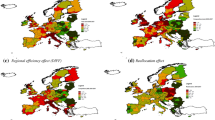Abstract
Economic reforms in Eastern Europe and Eastern Europe's integration into the world economy are supposed to induce fundamental changes into European trade patterns. This will affect regions in the EU differently, depending on location and specialization. The article quantifies the impact of changing trade flows on EU regional manufacturing. Estimates are based on comparative static simulations, using an empirically calibrated computable partial equilibrium model of interregional trade. The spatial EU output pattern under status-quo conditions is compared with an optimistic “successful reform scenario”. The article explains the model structure and its calibration, and presents results for 13 manufacturing industries.
Similar content being viewed by others
References
Bröcker, J. 1984.Interregionaler Handel und ökonomische Integration. München: Florentz.
Bröcker, J. forthcoming.Numerische multiregionale Gleichgewichtsanalyse. Heidelberg: Physica.
Cohen, D. 1992. The Solvency of Eastern Europe. In:The Path of Reform in Central and Eastern Europe, ed. European Communities. Luxembourg: Office for Official Publications of the European Communities.
Commission of the European Communities, Directorate-General for Regional Policies. 1993.Trade and Foreign Investment in the Community's Regions: The Impact of Economic Reform in Central and Eastern Europe, Regional Development Studies, No. 7. Luxembourg: Office for Official Publications of the European Communities.
Europäische Gemeinschaften, Generaldirektion Regionalpolitik. 1991.Die Regionen der Gemeinschaft in den 90er Jahren. Luxemburg: Amt für Amtliche Veröffentlichung der Europäischen Gemeinschaften.
Hamilton, C. B., and Winters, L. A. 1992. Opening up International Trade in Eastern Europe.Economic Policy, 7: 78–116.
Hughes, G., and Hare, P. 1994. The International Competitiveness of Industries in Bulgaria, Czechoslovakia, Hungary, and Poland.Oxford Economic Papers, 46: 200–221.
Landesmann, M., and Shields, J. 1992. Projections of East-West Trade Integration in Manufactured Goods. NERA Working Paper. London: National Economic Research Associates.
Rodrik, D. 1994. Foreign Trade in Eastern Europe's Transition. InThe Transition in Eastern Europe, Vol. 2, Restructing, eds. O. J. Blanchard, K. A. Froot and J. D. Sachs. Chicago: University of Chicago Press.
Rollo, J. M. C., and Smith, A. 1993. The Political Economy of Eastern European Trade with the European Community: Why so Sensitive?Economic Policy 16: 140–181.
Rollo, J. M. C., and Stern, J. 1992. Growth and Trade Prospects for Central and Eastern Europe.World Economy, 15: 645–668.
Rosati, D. K. 1992. Problems of Post-{MEA} Trade and Payments. CEPR Discussion Paper #650.
Author information
Authors and Affiliations
Rights and permissions
About this article
Cite this article
Bröcker, J., Jäger-Roschko, O. Eastern reforms, trade, and spatial change in the EU. Papers in Regional Science 75, 23–40 (1996). https://doi.org/10.1007/BF02406958
Issue Date:
DOI: https://doi.org/10.1007/BF02406958




